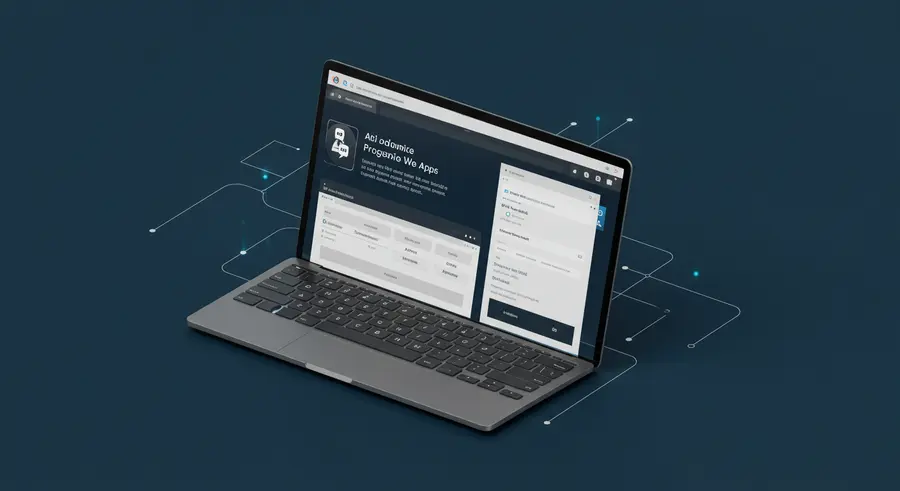Appearance

Welcome, fellow innovators and web enthusiasts! 👋 Today, we're diving deep into an exhilarating frontier where the web, artificial intelligence, and physical hardware converge to create truly intelligent and immersive digital experiences. We're talking about the next evolution of Progressive Web Apps (PWAs), supercharged with the power of AI and seamless access to device hardware.
If you're new to PWAs, you might want to start with the basics covered in our The Power of Progressive Web Apps (PWAs) article. But if you're ready to explore what's beyond the horizon, fasten your seatbelts! 🚀
What Makes PWAs So Powerful (and Even More So Now)?
PWAs already offer an incredible blend of web and native app capabilities: they're installable, work offline, send push notifications, and provide fast, reliable experiences. But with the rapid advancements in web APIs and AI, the possibilities are expanding exponentially.
🧠 The Brains: AI Integration in PWAs
Integrating Artificial Intelligence into PWAs isn't just a futuristic concept; it's happening now! AI can transform a PWA from a static application into a dynamic, personalized, and predictive tool.
- Personalized User Experiences: Imagine a shopping PWA that learns your preferences, not just from your past purchases, but by analyzing your browsing patterns, even your facial expressions (via camera access, with user permission, of course!) to recommend products. AI can power recommendation engines, personalized content feeds, and adaptive UIs that change based on user behavior and context.
- Intelligent Offline Capabilities: AI models can be run directly on the client-side using WebAssembly and frameworks like TensorFlow.js. This means your PWA can perform complex tasks, like image recognition or natural language processing, even when offline. Think of a language learning app that provides real-time pronunciation feedback without an internet connection!
- Predictive Features: AI can predict user intent, optimize resource loading, and even anticipate potential issues. A travel PWA, for instance, could use AI to predict flight delays based on real-time weather data and historical patterns, proactively notifying the user.
🖐️ The Hands: Hardware Access via Web APIs
Modern web APIs are bridging the gap between the web and the underlying device hardware, enabling PWAs to interact with the physical world in unprecedented ways. This opens up a plethora of opportunities for rich, interactive applications.
- Sensors Galore:
- Geolocation & Device Motion: Fitness PWAs can track your runs with GPS precision, while augmented reality (AR) experiences can overlay digital content onto the real world using gyroscope and accelerometer data.
- Ambient Light & Proximity Sensors: Imagine a PWA that automatically adjusts its theme (dark/light mode) based on ambient light or pauses content when you move your hand away from the screen.
- Connectivity & Peripherals:
- WebBluetooth & WebUSB: These APIs allow PWAs to communicate directly with Bluetooth and USB devices. Think of a PWA controlling smart home devices, health monitors, or even industrial machinery – all from your browser!
- NFC (Near Field Communication): Payment PWAs could offer tap-to-pay functionality, or an inventory management PWA could scan NFC tags on products.
- Camera & Microphone: Beyond simple video calls, these enable advanced features like:
- QR/Barcode Scanning: For retail, logistics, or event check-ins.
- Augmented Reality (AR): Building interactive overlays for education, gaming, or interior design.
- Speech Recognition & Synthesis: Creating truly hands-free voice interfaces for productivity apps.
Synergizing AI and Hardware Access in PWAs
The true magic happens when AI and hardware access are combined.
- Contextual Intelligence: A PWA leveraging geolocation and an AI model could provide hyper-local, personalized recommendations for restaurants or events based on your current location and expressed preferences.
- Enhanced Accessibility: AI-powered speech recognition coupled with microphone access can provide robust voice control for users with motor impairments. An AI model could even analyze facial expressions via the camera to understand user sentiment and adapt the UI accordingly.
- Interactive Learning & Gaming: Educational PWAs could use AI to analyze a student's handwritten notes (via camera and image processing) and provide instant feedback, while AR games could use AI to dynamically generate game elements based on the real-world environment captured by the camera.
The Road Ahead: Challenges and Best Practices
While exciting, this intelligent web frontier comes with its own set of challenges:
- Privacy & Security: Accessing hardware and personal data necessitates stringent privacy measures and transparent user consent. Developers must adhere to best practices for data handling and secure API usage.
- Performance Optimization: Running AI models and handling hardware streams can be resource-intensive. Efficient coding, WebAssembly optimization, and smart caching are crucial.
- Browser Compatibility: While support for these advanced APIs is growing, developers need to ensure progressive enhancement and graceful degradation for browsers that don't yet support all features.
Conclusion: Your PWA, Reimagined! ✨
The convergence of PWAs, AI, and advanced hardware access is not just a trend; it's a paradigm shift in how we build web applications. It empowers developers to create experiences that are not only performant and reliable but also intelligent, personalized, and deeply integrated with the user's environment.
The web is no longer just a canvas for displaying information; it's becoming a powerful platform for interaction, intelligence, and innovation. So, go forth and build the intelligent web – the future is now! 🌐🤖🤝